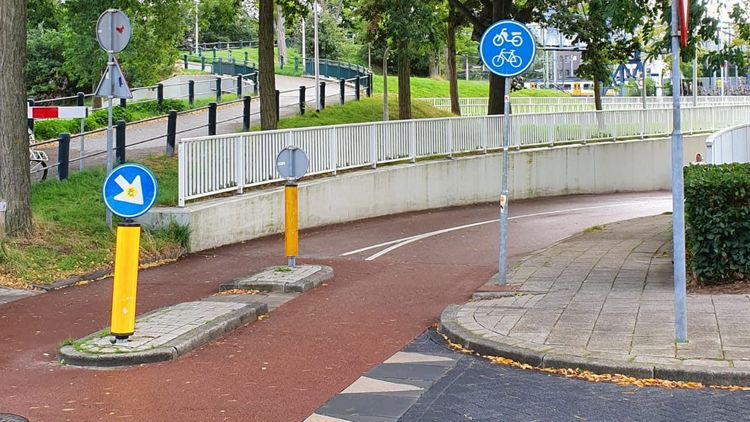Innovative technologies have the potential to make cycling safer, more attractive and more comfortable. Oldenburg business informatics researchers are investigating which solutions work best.
Traffic lights are a nuisance for many cyclists. In city traffic, those travelling by bike often have to stop every few meters at crossings while the cars on the road next to them speed past without annoying interruptions. Since the 1980s, motorised traffic in Germany has been regulated by electronic systems that have become increasingly intelligent over the years. They ensure that traffic lights switch according to the time of day and the situation on the roads, so that traffic flows as smoothly as possible.
So-called Intelligent Transport Systems (ITS) can also make cycling more attractive. Sometimes collectively referred to as "smart cycling", these technologies include intelligent traffic light circuits, assistance systems for improving traffic safety, traffic management systems and networks of sensors that exchange data with each other. "Individual European cities and regions are already testing several of these intelligent systems, but it’s difficult to determine their benefits because up to now very little data on the behaviour of cyclists has been available," says Prof. Dr. Jorge Marx Gómez, head of the Department of Business Information Systems/Very Large Business Applications (VLBA) at the University of Oldenburg.
Gómez and his team have been working for several months to remedy this problem. They are developing a data management platform called CycleDataHub which gathers and processes new and existing cycling data from various sources, visualises them and makes them available to different groups of users. The platform will contain various types of data including count data and information on cycle path networks, accidents, green signal phases and cycle traffic volumes. The data can then for example be used by traffic planners to gain insights into the needs of cyclists, so that transport policies can be adapted accordingly.
The Oldenburg scientists’ research is part of the “Bicycles and Intelligent Transport Systems“ project (BITS), an EU project in which in addition to the University of Oldenburg, the VIVES University of Applied Science in Belgium, six cities and regions in the Netherlands, Belgium, Denmark and the UK as well as the Oldenburg-based company baron mobility service (mein-dienstrad.de) and Cycling Industries Europe as an interest group are involved. BITS is funded by the European Regional Development Fund’s Interreg North Sea Region Programme. It will receive about five million euros in funds over a three-year funding period which began at the start of 2019. The Dutch province of Overijssel is in charge of the overall management of the project.
Fast track to the city centre
The goal of the BITS project is to increase bicycle use in the project regions by ten percent and thus reduce CO2 emissions by about the same amount. "The consortium aims to identify exemplary solutions in the field of smart cycling and then transfer these solutions to other countries," Marx Gómez explains. For example, the province of Overijssel and its capital Zwolle is considered to be one of the most cycling-friendly regions in the already cycling-friendly Netherlands. Cyclists can ride all the way to the city centre unimpeded on fast lanes which use bridges and underpasses to avoid busy road sections. They also have right of way at many traffic lights, and cycling accounts for about half of all traffic in Zwolle. In the county of East Riding in Yorkshire, England, which is also a partner in the BITS project, bikes are used more frequently than in the surrounding areas of northern England. However, the proportion is still relatively small: only eleven percent of the population use their bikes at least once a week here.
The city of Antwerp, which is also involved in BITS, provides an example of how data on cycling can be put to good use. Researchers have been gathering detailed information on bicycle mobility for some time now here. Mobile and stationary counting loops measure the volume of traffic on the main cycling routes, and cameras will soon be used at certain intersections to observe cyclists more closely and thus gain further insights into their cycling behaviour.
The result of these measurements is the "Fietsbarometer", a web application that features a map with regularly updated information on the Belgian city's cycle path network – including data on road surfaces, accident blackspots and bicycle parking spaces. The Fietsbarometer provides valuable information not just for traffic planners, but also for cyclists themselves. The Oldenburg business informatics specialists are now working on integrating this and other applications into the CycleDataHub. "One of the first main tasks will be to develop a common understanding of cycling data in the project in order to improve the possibilities for comparison," explains Johannes Schering, a member of the research team. Schering has already developed a concept for storing and using the collected information in accordance with data protection regulations.
As the project progresses, further innovative technologies will be put to the test, including navigation systems, sensors that collect route and environmental data, and counting systems, as well as distance sensors that emit a signal when a car gets too close to a cyclist. These devices are all designed to improve the safety of cyclists.
The BITS project is also addressing the question of how to avoid annoying halts at traffic lights using smart technology. The city of Zwolle is planning to give priority to cyclists outside peak hours – with smartphone apps that communicate with traffic lights to ensure that cyclists approaching crossings get a green light.








